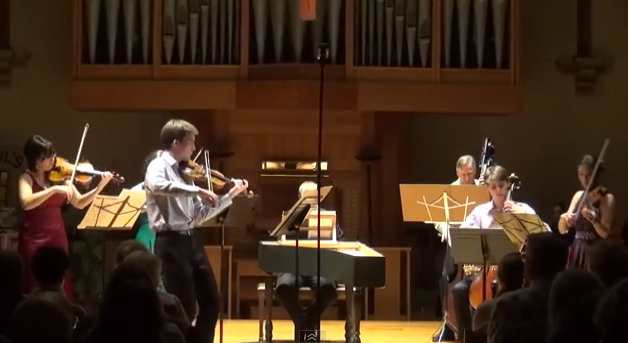Concert Review: Mistral — A Welcome Act of Musical Chutzpah
Mistral’s Artistic Director and flutist Julie Scolnik knows, after 17 successful years, how to run a terrific series – hire the best people, present a unifying theme, and program excellent music.
By Susan Miron
I often feel we are living in an extraordinary time for chamber music. Boston alone boosts myriad good groups, and people flock to their concerts. So it takes a little chutzpah to enlarge a series based in Andover (Andover Chamber Music) and establish a base here under the name of Mistral.
But Mistral’s Artistic Director and flutist Julie Scolnik, knows, after 17 successful years, how to run a terrific series – hire the best people, present a unifying theme, and program excellent music. All else – being audience-friendly, offering tasty cookies at intermission, letting kids in for free – is the icing on top. Scolnik does it all with aplomb.
Friday’s concert, “The Baroque Big Band 2013,” was held at Brookline’s St. Paul’s Episcopal Church, a popular venue with excellent acoustics but inadequate parking. Most of the usual Baroque Suspects showed up – Vivaldi, Telemann, J.S. Bach, his son C.P.E. Bach, and Corelli. I must admit, with the exception of the Bach concerto, I would have ordinarily passed on a standard Baroque program, but I had heard two of Mistral’s unusually challenging concerts before and wanted to hear if they were as good as I thought they were.
Well, they were terrific. They opened with Concerto Grosso in D by Vivaldi (1678-1741), with violinist Gabriela Diaz (who is surely and deservedly the busiest chamber music violinist in town) leading an ensemble of three violins, a viola, cello, and bass. Diaz’s commanding presence exuded tremendous energy. Next was Telemann’s (1681-1767) “Tafelmusik: Quartet in d minor” with added recorder (Aldo Abreu) and flute (Julie Scolnik). Abreau contributed a lovely recorder cadenza, and the others played with great spirit and lots of energy. This was far from the snore that other groups make of Baroque music.
Scolnik prides herself – as well she might – at having seasoned (read: middle-aged) players along with those still in training, and her son is the best example of the latter. Sasha Scolnik-Brower, now a freshman at Harvard University and also studying at the New England Conservatory, is a sensational cellist, the winner of numerous awards. Friday he provided an elegant continuo along with harpsichordist Dylan Sauerwald. He is certainly a cellist to watch. The Telemann gave him many opportunities to show off his talents, and he was as impressive as his seniors.
Bach’s Concerto for Violin and Strings, BWV 1052, is the same as the D minor Piano Concerto, which is believed to have been based on a lost violin concerto. Here each of the three violinists – Diaz, Muresanu, and Alexi Kenney – were given the opportunity to play the solo violin part in all three movements. I have heard Diaz and Muresanu many times before and admire them enormously: a young violinist proved he could hold his own in their company. Kenney has just won the very prestigious Concert Artists Guild Competition, so you’ll be sure to hear of him again. For me, this was the high point of the concert, featuring a wealth of gorgeous violin playing.
C.P.E. Bach’s (1717-1788) well-known Flute Concerto in A has an interesting history. It exists in 3 standard versions – as concertos for flute, harpsichord, and cello. My husband, a violist, played his own version of the piece based on a transcription by the cellist Gaspar Cassado. Scolnik gave a very elegant rendition. Its famous third movement is known by Bostonians as the signature music for the old WCRB. Corelli’s (1653-1713) Concerto Grosso, Op. 6, No.8, “Christmas,” had Irina Muresanu as first violin, which gave us another chance to enjoy her artistry. The Finale from Telemann’s Concerto in E minor for recorder and flute provided the two winds with another chance to shine, and gave the happy audience a fun end to a most enjoyable December evening.
Susan Miron, a harpist, has been a book reviewer for over 20 years for a large variety of literary publications and newspapers. Her fields of expertise were East and Central European, Irish, and Israeli literature. Susan covers classical music for The Arts Fuse and The Boston Musical Intelligencer. She is part of the Celtic harp and storytelling duo A Bard’s Feast with renowned storyteller Norah Dooley and plays the Celtic harp at the Cancer Center at Newton Wellesley Hospital.


